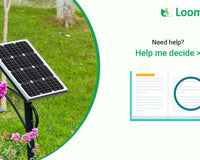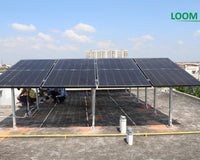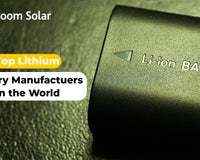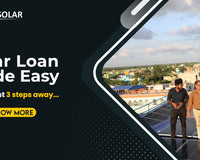Buying a battery is not an easy task. You have a lot to consider. The size of the battery will depend upon your power requirement, price, warranty, life, maintenance, etc. With passing time, there are regular technology upgrades and new technologies and models are launched every day in the market which leaves you even more confused. Besides, there are different types of batteries that are available in the market like lithium-ion, lead-acid, etc. All these factors often tend to confuse the buyers. We are, therefore, writing this article with an aim to help you make informed decisions.
Perfect Energy Storage
2 times battery life, consumes 50% less space, needs no maintenance & takes 60% less recharge time
Battery Industry

The battery industry is a multi-billion-dollar industry and continues to grow, driven by high demand for products ranging as far and wide as mobile technology, smart consumer electronics products as well as electric vehicles. As the population grows the demand for these products will also continue to grow. Lithium batteries are gaining rapid momentum as they are finding increased application in electric vehicles and for power backups in renewable energy systems. Future use of these batteries can be found in electric vehicles, industrial machinery, and power storage.
Inverter Battery

The term “Inverter Battery” means a battery used for the home inverter. Inverter batteries are designed to provide a small amount of current consistently for a longer period of time. Inverter batteries are not discharged over a much longer time. Inverter batteries are not discharged over a much longer time. The performance and life of an inverter depend on its battery. As such a battery is a critical and main component of an Inverter battery.
Lead-acid batteries have been around for over 150 years. The technology has been evolving over the century with flat plate models with a lattice grid in 1881 and tubular construction later. Tubular batteries proved to provide better performance and improved reliability as compared to flat plate technology. It used non-woven gauntlets encasing the positive spice plate and other advanced manufacturing techniques.
There is a wide difference in the charge cycles of flat plate and tubular batteries. The charge cycle of a Flat Plate Battery is 50 – 100 Times @ 80% DOD, while the charge cycle of a Tubular Battery is 1100 – 1800 times. The price of an inverter battery varies depending upon the battery technology and capacity. The most popular lead acid battery for the home inverter is 80 Ah, 120 Ah, 150 Ah, and 220 Ah. Home lighting systems in rural areas use 7 Ah, 20 Ah, and 40 Ah lead-acid batteries.
UPS Battery

The importance of being online all the time is now more than forever with most people working still from home. Such kind of batteries is required in the hospitality industry like hotels and hospitals where continuous power is required 24*7. The key to an Uninterruptable Power Supply (UPS) is the battery system that assists its continuous operations. A UPS is practically useless without a well-maintained and quality battery system. If the battery fails, the functioning of the UPS will also be seriously affected. Batteries constitute a major chunk of the total cost of a UPS and hence need to be properly maintained. To date, traditional sealed lead-acid batteries are mostly used in UPS battery although alternatives such as lithium-ion are becoming popular and also viable.
Lithium-Ion Battery

The lithium-ion battery manufacturing process comprises cell to battery-pack manufacturing, which involves a value-add of 30% to 40%, battery chemicals with a value of 35% to 40% of the total cost of the battery pack. The cell to pack manufacturing plants have started functioning, however, other facilities are still not there. India is ready to provide numerous incentives for such manufacturing units. India has a current minimum requirement of 10 GWh of cells by 2022, which is expected to increase to ~50 GWh by 2025.
Difference between Lithium-ion and Lead-acid Batteries
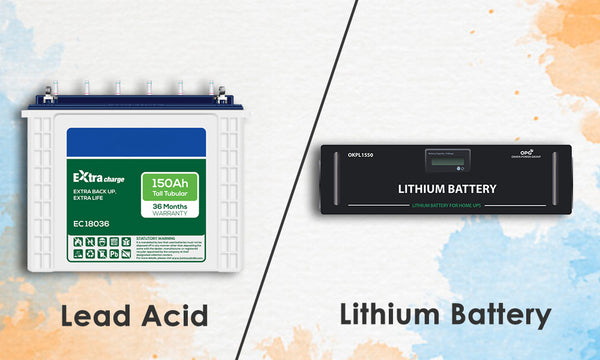
Batteries having lithium as their anode are lithium batteries. The price of lithium batteries has declined by more than 80% in the last decade. Lithium batteries can also be used in cars, homes, UPS, toys, and remote controls.
#1. Lead-acid batteries are very heavy and bulky. They are not ideal for fast charging as they overheat at the time of charge. Its short typical cycle life ranges from 300 to 500 cycles. These are not popular choices due to their dependence on hazardous metal lead and low energy density.
#2. CYCLIC PERFORMANCE - Lithium battery capacity is independent of the discharge rate. This is one of the most notable differences between lithium-ion and lead-acid batteries. Lithium-ion is a low maintenance battery and the self-discharge is also less.
#3. CONSTANT POWER DELIVERY - Lithium batteries are better as they can deliver the same amount of power throughout the entire discharge cycle. Lithium batteries can charge within 4 hours at most, whereas lead-acid batteries generally take 10 hours of charge time.
#4. HIGH TEMPERATURE PERFORMANCE - In high-temperature applications, Lithium battery’s performance is far more superior compared to SLA (sealed lead-acid VRLA or a valve-regulated lead-acid battery). For instance, lithium has twice the cycle life at 55°C, as SLA does at room temperature.
Indian Auto-Industry Today

There are numerous reasons why your next car must be electric. On one hand, the fuel cost of using a conventional vehicle is too high, on the other, fuel causes a lot of harmful emissions which is leading to hazardous pollution. Trends like climatic change, technology advancements in renewable energy, rapid urbanization, data capture and analysis, battery chemistry, and energy security have acted as strong tailwinds for growth.

1. Two-wheelers: 79% of the total number of vehicles.
2. Three-wheelers (passenger and goods), including tempos: 4% of the total number of vehicles.
3. Buses and large goods vehicles like trucks: 3% of the total number of vehicles.
4. Economy four-wheelers (cars costing less than ₹1 million): 12% of the total number of vehicles.
5. Premium four-wheelers (cars costing higher than ₹1 million): 2% of the total number of vehicles.
Going electric has become a top priority for developed economies, such as the EU, the USA, and Japan, as well as developing economies such as China and India. The EVs will go a long way in reducing carbon emissions while providing convenient and cost-effective mobility.
What is Battery Cell?

Battery cells have inherent electrical, environmental, and mechanical hazards. It is very important to maintain the proper temperatures. A battery cell can rupture or explode when overcharged or overheated leading to a compromised battery making it more susceptible to future damage from vibrations, impact, or heat.
Hence it is crucial to subject battery packs to regulatory testing requirements, in order to protect them from possible safety threats. UL is a testing lab to ensure the safety parameters of battery components, such as Battery Cells & Battery Pack and BIS is a certifications lab that certified battery manufacturers need to comply with, to sell products in India. Manufacturers are expected to comply with these standards for producing quality products.
Charge & Temperature
Battery cells are subject to overcurrent, overvoltage, and over-temperature conditions when charging and discharging. They require protection from being overcharged and discharged too far. Excessive heat causes faster degradation of these batteries. Storage in a cool place at 40% charge reduces the aging effect. The charging process for Lithium-Ion batteries consists of two phases: constant current and constant voltage.
What is Constant Current?
In the constant current charging phase, the charge current is applied constantly to the battery until the voltage limit per cell is reached. Lithium-Ion batteries cannot receive a voltage higher than 4.2V typically, or as specified, without being damaged.
What is Constant Voltage?
As the applied current begins to decline by a small percent of the constant charge current, the constant voltage phase begins when the maximum cell voltage is applied to the battery. A balancing phase is reached between the constant current and constant voltage phases, in the case of multi-cell battery packs, ensuring a consistent charge between cells. In such packs, the voltage applied in the constant voltage stage is the product of the number of cells and the maximum voltage per cell.
Voltage = No. of cells x Maximum Voltage per cell
Charging & Discharging Process
As at the time of charging, care must also be taken at the time of discharge. Lithium-Ion battery cells must never be discharged below their specified minimum voltage. Once voltage drops to the minimum level, the flow of current will stop. This ensures that the battery can be recharged safely with a conventional charger. It also protects the battery from a short circuit.
Battery Installation

One of the major things to keep in mind while installing a lead-acid battery is to keep it properly ventilated. Positioning is absolutely crucial to enable the release of the gasses. You won’t face any such problem with a lithium battery, as the cells are sealed and cannot leak. So you are free to install a lithium-ion battery in any position without any restrictions pertaining to orientation - can be installed on its side, upside down, or standing up.
Conclusion
We have tried and cover everything about batteries here. If you find anything missing here, or if you have additional questions, please feel free to contact us.






